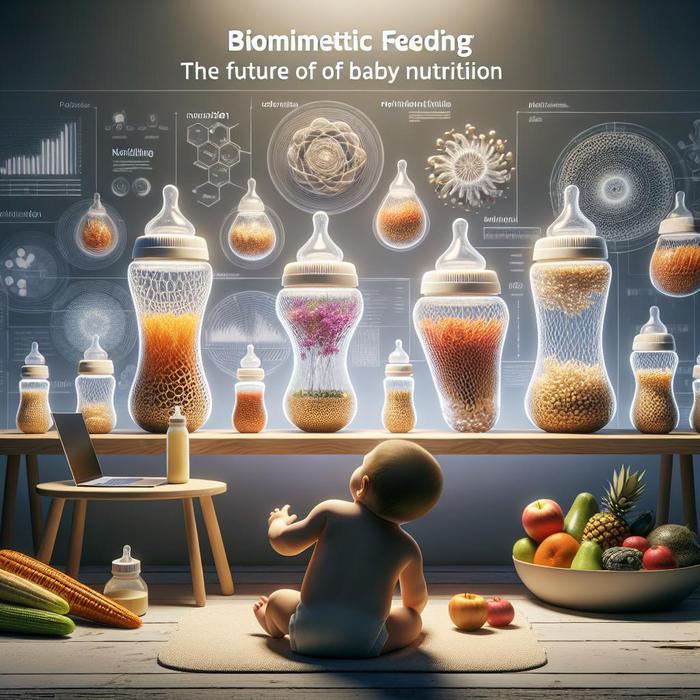The New Frontier in Infant Nutrition: Biomimetic Feeding
As technology continues to evolve, there are exciting innovations happening in every field, including infant nutrition. The newest development? Biomimetic feeding. This method is a revolutionary nutritional approach that aims to replicate the benefits of breastfeeding as closely as possible, providing newborns with essential nutrients and fostering healthier development.
Understanding Biomimetic Feeding
Biomimetic feeding is based on the principle of biomimicry, which involves emulating nature’s systems, processes, and elements to solve complex human problems. In the context of infant nutrition, it’s about mimicking the natural process of breastfeeding. This includes not only the nutritional content of mothers’ milk but also the physical act of feeding itself.
But how exactly is biomimetic feeding taking shape in the world of baby nutrition innovations? Let’s delve deeper.
The Nutritional Aspect
The cornerstone of biomimicry in infant nutrition is the attempt to replicate human milk’s nutritional profile. Breast milk is known for its unique composition, featuring an optimal balance of proteins, fats, carbohydrates, vitamins, minerals, and bioactive components. It’s a dynamic fluid constantly changing to meet the baby’s nutritional requirements in response to both environmental influence and infant growth [1].
- Proteins: Research indicates the potential of using plant-based proteins to mimic the protein structure of human milk [2]. This is particularly beneficial for babies struggling with cow’s milk protein allergies.
- Fats: Fatty-acid profiles, essential for brain development, are another focus. These are often derived from algae and other plant sources to replicate the beneficial fats in breast milk.
- Carbohydrates: The type, concentration, and composition of carbohydrates, especially human milk oligosaccharides (prebiotic fibers), are integral in supporting a healthy gut microbiome [3].
- Others: The inclusion of additional beneficial ingredients, like probiotics and micronutrients, is also a part of biomimetic feeding.
By mimicking the nutritious composition of breast milk, biomimetic feeding provides a more suitable alternative for infants who cannot be breastfed due to various reasons.
The Physical Aspect
Besides nutritional composition, biomimetic feeding also emphasizes mimicking the physical act of breastfeeding. Various innovators, including emulait.com, are designing feeding systems that mimic the breastfeeding experience to support the infant’s oral development. This encourages natural suckling patterns, aiding in better digestion and reducing issues like colic and spit-up.
The choice of pediatrician and their knowledge about these latest advancements can significantly influence how well these biomimetic feeding methods are implemented and the benefits that your baby receives.
Preparing For This Innovative Journey
Transitioning to biomimetic feeding can be a significant shift from traditional feeding methods. It’s crucial to prepare a conducive home environment that fosters your baby’s development while adopting this innovative approach.
Remember, Your Journey Is Unique
As with any new method, biomimetic feeding may present challenges as you adjust to it. Patience, perseverance, and professional advice are key to navigating this journey. Always remember that your baby’s nutritional journey is unique and it’s okay to seek help if you need it. You can refer to our helpful baby teething relief tips for additional support during those tough teething phases.
Embrace the future of baby nutrition with confidence. Stay informed, trust your instincts, and give your little one the best nutritional start possible with biomimetic feeding.
The Role of Research in Biomimetic Feeding
Research plays a crucial role in biomimetic feeding. To recreate the complexities of breast milk as closely as possible, we need to understand its intricate composition and variability [4]. This also aids in tailoring feeding methods to the specific requirements of each baby. Biomimetic feeding continuously evolves as new research and advances in technology occur.
Supporting Moms in Biomimetic Feeding
While the focus is often on the benefits of biomimetic feeding for babies, it’s also critical to offer support for moms. Breastfeeding challenges can be overwhelming, and biomimetic feeding can be a comforting solution. Make sure you and your partner understand the process and can provide each other with the necessary assistance. For moms who plan to use bottle-feeding, maintaining the breastfeeding bond with a bottle can be essential to reinforcing the emotional connection between mothers and babies.
Community and Professional Support
Support from professional health advisors, pediatricians, and the community is invaluable in the process of biomimetic feeding. They can provide guidance, care instructions, and practical feeding advice, ensuring that your baby is receiving optimal nutrition. They can also address any concerns or questions you might have about biomimetic nursing.
Furthermore, bottle-feeding support for moms can offer additional assistance on this innovative feeding adventure. Remember, asking for help is not a weakness but a sign that you put your baby’s needs first.
Biomimetic Feeding and Allergies
Children with allergies, particularly to cow’s milk protein, may greatly benefit from biomimetic feeding. The alternative ingredients used in this process can be beneficial and prevent allergic reactions [5]. However, it’s always wise to consult a professional before making any significant changes to your baby’s diet.
Transitioning to biomimetic feeding is not always a smooth ride. Every baby is unique, and adjusting to new routines, tastes, and feeding techniques can take some time. It’s essential to be patient and adaptable, keeping your baby’s comfort and well-being at the forefront of any decisions made.
Final Thought
The sphere of infant nutrition is ever-evolving, and biomimetic feeding is a promising approach that aims to meet the unique nutritional needs of every baby. The journey to embracing this new frontier in infant nutrition might be challenging but remember, you’re not alone. The benefits that biomimetic feeding offers for your child’s growth and development will likely outweigh the hurdles encountered along the way.
Embrace the future, and arm yourself with knowledge. Your baby’s nutritional journey is unique, and with biomimetic feeding, you can give them an optimal start to life.
The New Frontier in Infant Nutrition: Biomimetic Feeding







